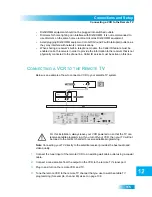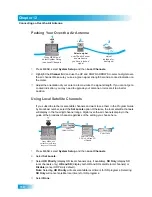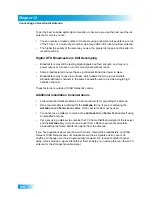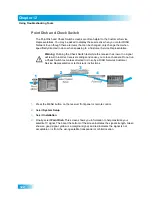
Connections and Setup
119
Connecting an Over-the-Air Antenna
Transmit Channel Numbers
For information on channel numbers, you can visit the National Association of
Broadcasters (NAB) web page at www.nab.org.
For a list of digital broadcast stations and their Transmit Channel numbers go to
www.nab.org/AM/ASPcode/DTVstations/dtvstations.asp.
Note: Where Transmit Channel is displayed by the receiver, the NAB web page uses the
term RF Channel. These terms mean the same thing.
Another good source of local channel information is available from the Consumer
Electronics Association (CEA) web page at: www.antennaweb.org. This website provides
recommendations for antenna types and pointing directions.
About Over-the-Air TV Broadcasts
Over-the-air TV signals are broadcast from stations on the ground, while satellite TV
signals are broadcast from satellites in space. You receive over-the-air TV signals using
an indoor or outdoor antenna instead of the satellite dish. You are likely familiar with
analog over-the-air TV signals—these are the signals that have been used to broadcast
TV for many years. New digital over-the-air TV signals are broadcast and received in the
same way. Digital over-the-air TV broadcasting uses advanced technology like that of
DISH Network to deliver superb picture quality and CD-quality sound. However, digital
over-the-air signal reception (like analog over-the-air signal reception) depends on several
things:
•
The distance between the broadcast station and your home (the farther away the
station, the weaker the signal).
•
The broadcast station's power (the lower the power, the weaker the signal).
•
Obstacles between the station and your home, such as mountains, buildings, trees, or
other objects (these may block or reflect the signal before it reaches you).
•
Multiple broadcast stations (to receive good signals from several stations, you may
need to compromise in how you aim the antenna or you may need more than one
antenna).
The effects of poor digital reception are different from the effects of poor analog reception:
•
Poor analog reception usually causes the TV picture to be “snowy” or to include
“ghosts,” that is, multiple images caused by receiving reflected signals along with the
direct signal from a station.
•
Poor digital reception may cause the TV picture to be “pixelized,” that is, broken up
into small squares of various colors, or to be lost completely (the TV screen is all black
or all blue).
•
Digital broadcasts often provide either a very good picture or no picture at all.
•
You may be able to receive a poor analog signal but not be able to receive a digital
signal at all.
Summary of Contents for DuoDVR ViP 622
Page 1: ......
Page 2: ......
Page 19: ...10 Questions Chapter 1 Notes...
Page 47: ...38 Notes Chapter 4 Notes...
Page 81: ...72 Notes Chapter 9 Notes...
Page 169: ...Notes 160 Notes...
















































